“Isn’t it hard to believe this was a derelict site a few years ago?” asks JJ O’Hara, waving around the Manorhamilton development known as W8, named after the Leitrim town’s GPS co-ordinates.
Lunchtime chatter from the award-winning Osta restaurant seeps into what was once a crumbling ghost estate. A two-minute walk away, refurbishment works are in full swing on the town’s main street.
W8 is home to a holiday village, Osta and a mix of business projects ranging from Future Cast, experts in 3D concrete printing, to a Department of Agriculture hen harrier preservation programme.
“Manorhamilton is a dynamic town,” agrees sculptor Jackie McKenna, who was reared with her six siblings over a grocery shop on the main street and who as co-founder of the Leitrim Sculpture Centre helped start the flow of artists to the area.
READ MORE
The town, about 12km from the Border, has its fair share of challenges, but a few years after local builder Shane Kerrigan took a chance and purchased the abandoned, unfinished development, a casualty of the 2008 economic crash, it has evolved into the W8. And now his company is working on a €2 million upgrade of the town’s streetscape for Leitrim County Council.
[ Gold and silver prospecting licence puts Leitrim ‘under siege’Opens in new window ]
“We’re just trying to regenerate a small town in rural Ireland‚” says O’Hara, chief executive of Future Cast, which carries out research and training for the construction sector. He is very excited about developments in the sector and believes that within five years, 15 per cent of new builds will be 3D printed. The Manorhamilton-based business is collaborating with Louth Meath Education & Training Board and the company Harcourt Technologies, and O’Hara hints that Ireland’s first 3D-printed house may be completed within weeks.
The Leitrim man was an energetic leader of the Border Communities against Brexit campaign, so much so that former German MEP Elmar Brok got him involved in peace talks between Ukraine and Russia in 2019.
O’Hara and McKenna may be dynamos in the town when it comes to business and the arts respectively, but other locals have stepped up and are the faces of the Grá le Manor campaign aimed at ensuring that any disruption caused by the council’s €2.1 million Public Realm Improvement Scheme does not interfere with day-to-day activities in the town.
Footpaths are being widened, street lighting and furniture installed, and a meeting space provided in front of the landmark building, the Market House. Throughout the work, business owners including a pharmacist, publican and butcher are featuring in a poster campaign reassuring their customers that they remain very much open for business.
Today, Saturday, April 8th, business may not be booming because, according to Enda Stenson, chairman of the Leitrim GAA county board, “half the county is in New York” for the first championship game of the season. Among those at the game in Gaelic Park in the Bronx is Manorhamilton pharmacist John MacManus, one of the faces of the Grá le Manor campaign and also one of the sponsors of Leitrim GAA.
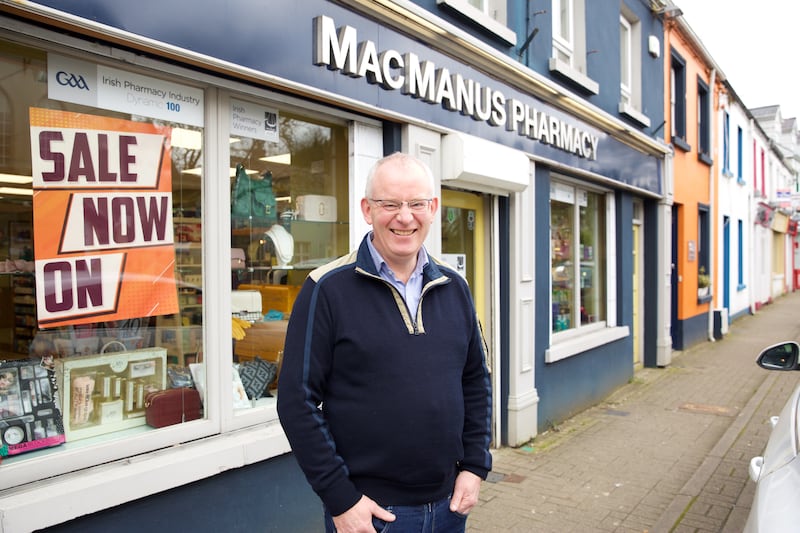
“All you get is bragging rights – we don’t do it for the wins,” he joked. MacManus is enthusiastic about the refurbishment works and has no gripes about the disruption.
“You can’t make an omelette without cracking an egg,” he says. “The street works will make the town more attractive, with a place for gigs on a summer evening, and more people eating outside.”
[ Ancient fleece paving method used to protect soft peatland routeOpens in new window ]
While not part of this scheme, locals are hoping that the environs of Manorhamilton castle, synonymous with the notorious “hanging Hamilton”, will be the setting for a public space also being planned.
If I took a notion on a good day to pull out the door at four o’clock, I could be at the beach or out fishing in half an hour
— Bernie McGauran
Proud of Leitrim’s history, MacManus says the first and second signatories of the 1916 Proclamation were Leitrim men. Sean MacDiarmada, who had an office around the corner from his pharmacy, was from nearby Kiltyclogher, while Tom Clarke’s father James was from Carrigallen.
Butcher Susan Thornton has had a bird’s-eye view of Manorhamilton’s more recent history and has seen a lot of changes since she and her late husband Sean opened their shop 44 years ago.

“We have lost two banks, Bank of Ireland and Ulster Bank, and two supermarkets from the main street. Several pubs have gone.”
Her son Damien, known locally as “Babe”, followed her into the business and provides a farm-to-fork service, having his own farm and abattoir.
Susan went back to college in 2002 and as a qualified psychotherapist agrees that counselling skills can be useful in a butcher’s, although “people don’t have as much time to chat these days naturally because it takes two people to pay a mortgage”.
Sisters Teresa and Dympna Mawn run Manor Boutique, which was started as a drapery shop by their mother Mary when they were small children. Mary is one of the few people in town still living over the shop.

“She moved in as a widow with four small kids. It was lovely living over the shop. It used to be a boarding house and it’s a beautiful building,” says Dympna.
She has no worries about a slump in business if roadworks make it difficult to navigate the town. “If I wanted to go into a clothes shop I would climb over fire. It would take more than street works to stop me buying a dress,” she laughs.
[ Leitrim-based film director to give a different perspective on moon landingOpens in new window ]
Joanna Golaf opened Polka, her busy Polish shop in Manorhamilton, in 2020, just after lockdown. “We get lots of Polish people, lots of nationalities and Irish people too,” says Golaf, who moved to Ireland 15 years ago and whose three sons are Irish-born.
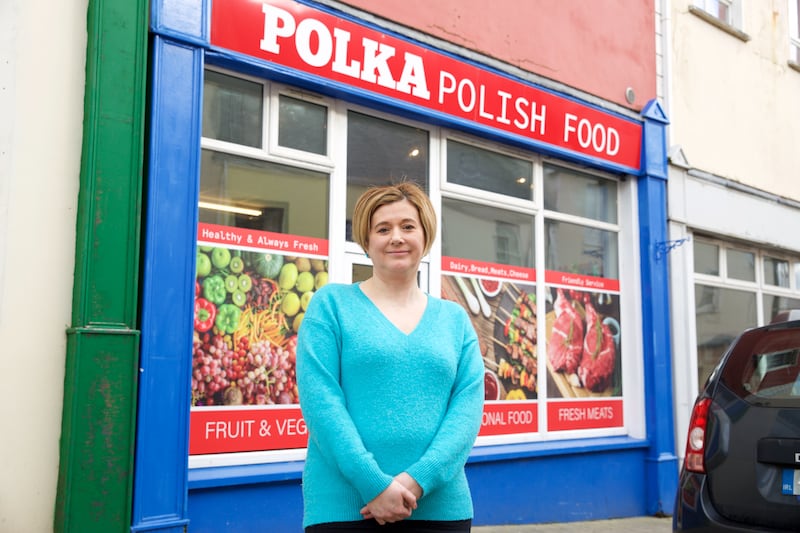
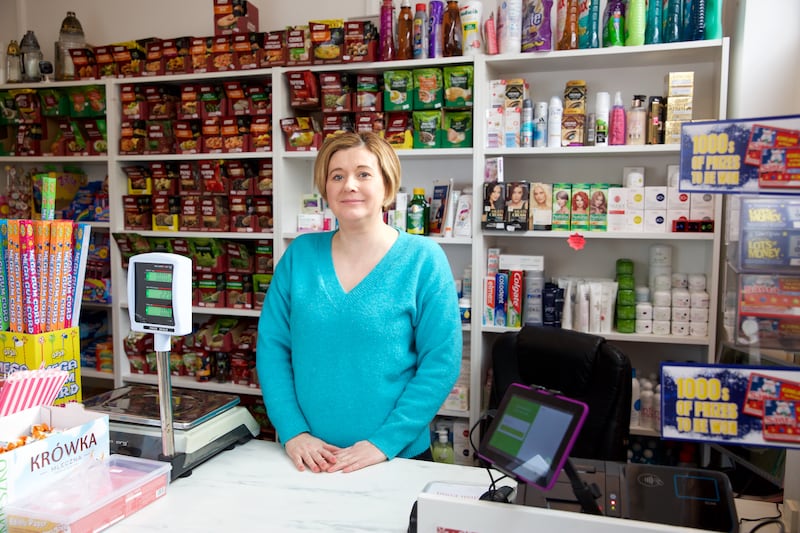
“I’m from Warsaw. Manorhamilton is quieter,” she says. “I like it here.”
Another face of the Grá campaign, Cormac O’Mahony from Biddy’s Bar on Main Street, also lives on the premises – one of the most historic in town.
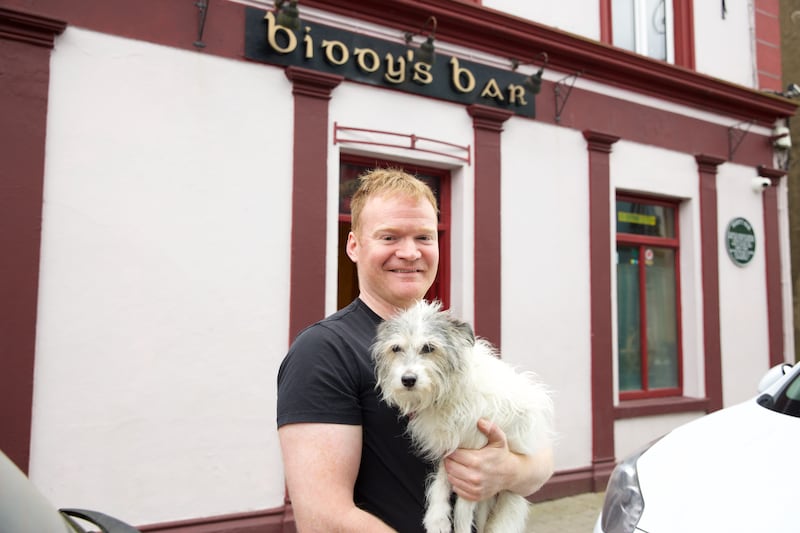
It was owned by MP Francis E Meehan, who represented north Leitrim in Westminster from 1908 to 1918, and who operated a grocer’s and pub in what is now Biddy’s. O’Mahony’s dog, 14-year-old Sally, stays close to a blazing open fire there. “She is the landlady,” says the publican, who reckons he is lucky to have such a short downstairs “commute” to work.
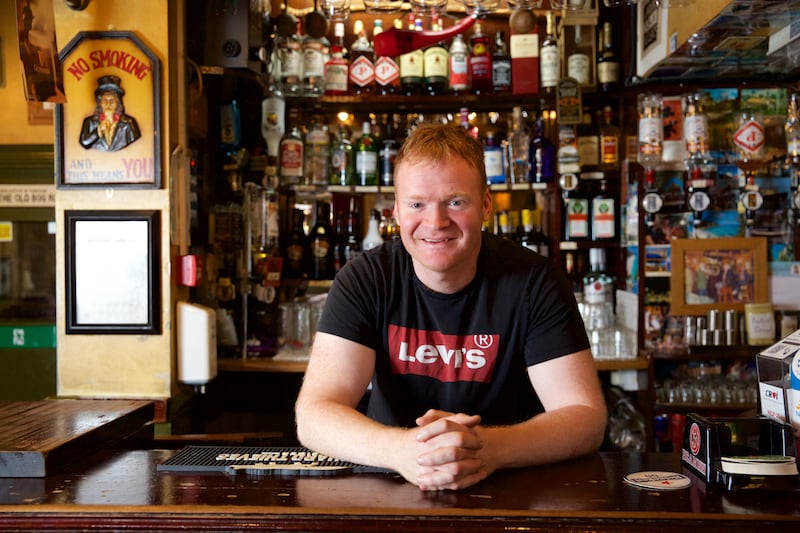
Bernie McGauran, whose company Lock Up Alarms employs 10 people, says anyone driving through Manorhamilton might not realise that 900 people come to work there every day with MCi (Mirror Controls International) and the HSE, both big employers.
Since Covid-19 prompted many city residents to move to rural areas, he believes the place has much to offer.
“If I took a notion on a good day to pull out the door at four o’clock, I could be at the beach or out fishing in half an hour.”
McGauran doesn’t heed any negative chatter about disruption during the street upgrading. “The same people would give out if it wasn’t happening. Most people will just get on with it.”
Like the sculpture centre, the Glens is a busy arts venue which has boosted Manorhamilton’s reputation as a creative hub. Its director, Dubliner Brendan Murray, agrees the place seems to a magnet for creatives.
We have very creative youth and they love making the props and they learn a lot about woodwork and welding, but we work in a shed with no electricity and it is freezing cold
— Jackie McKenna
“At the last census there were more artists living in north Leitrim per capita than anywhere else.
“Once they set up the sculpture centre it started to bring in artists from other genres,” he says. Kila band members Rossa O’Snodaigh and Dee Armstrong are local residents.
Jackie McKenna, who founded the sculpture centre with fellow artist Seamus Dunbar in the 1990s, welcomes the plans to improve Manorhamilton’s streetscape, but says the many vibrant local community groups have nowhere to meet.
“As much as I love improvements on the streetscape, I think we need a place for people to meet – it rains a lot.
“There is a glaring absence of indoor community spaces unfortunately for groups like the Carnival Arts Collective, the North Leitrim Sustainable Energy Community, the Historical Society, and the 24/7 Family Carers.” Her dream is that the former courthouse could get the injection of funding needed to house all those groups.
“It is an amazing building,” says the Manorhamilton native, who remembers a time when the town centre was populated by families. “There were seven in my family. There must have been 30-kids-plus on my street.
“It was wonderful, We had gangs. We had the main street gang and the Castle Street gang. Everyone gathered at the back of our place.”
She says that thanks to Dee Armstrong, Manorhamilton hosts a spectacular Samhain parade every year. “We have very creative youth and they love making the props and they learn a lot about woodwork and welding, but we work in a shed with no electricity and it is freezing cold.”
Having previously been involved in a Youthreach programme for early school leavers, she thinks if a venue was available, young people in Manorhamilton could flourish and learn new skills.
But McKenna is positive about the future.
“In the last six months two premises have been taken over by artists on the main street. There are younger artists coming into Manorhamilton, which I love.”

















